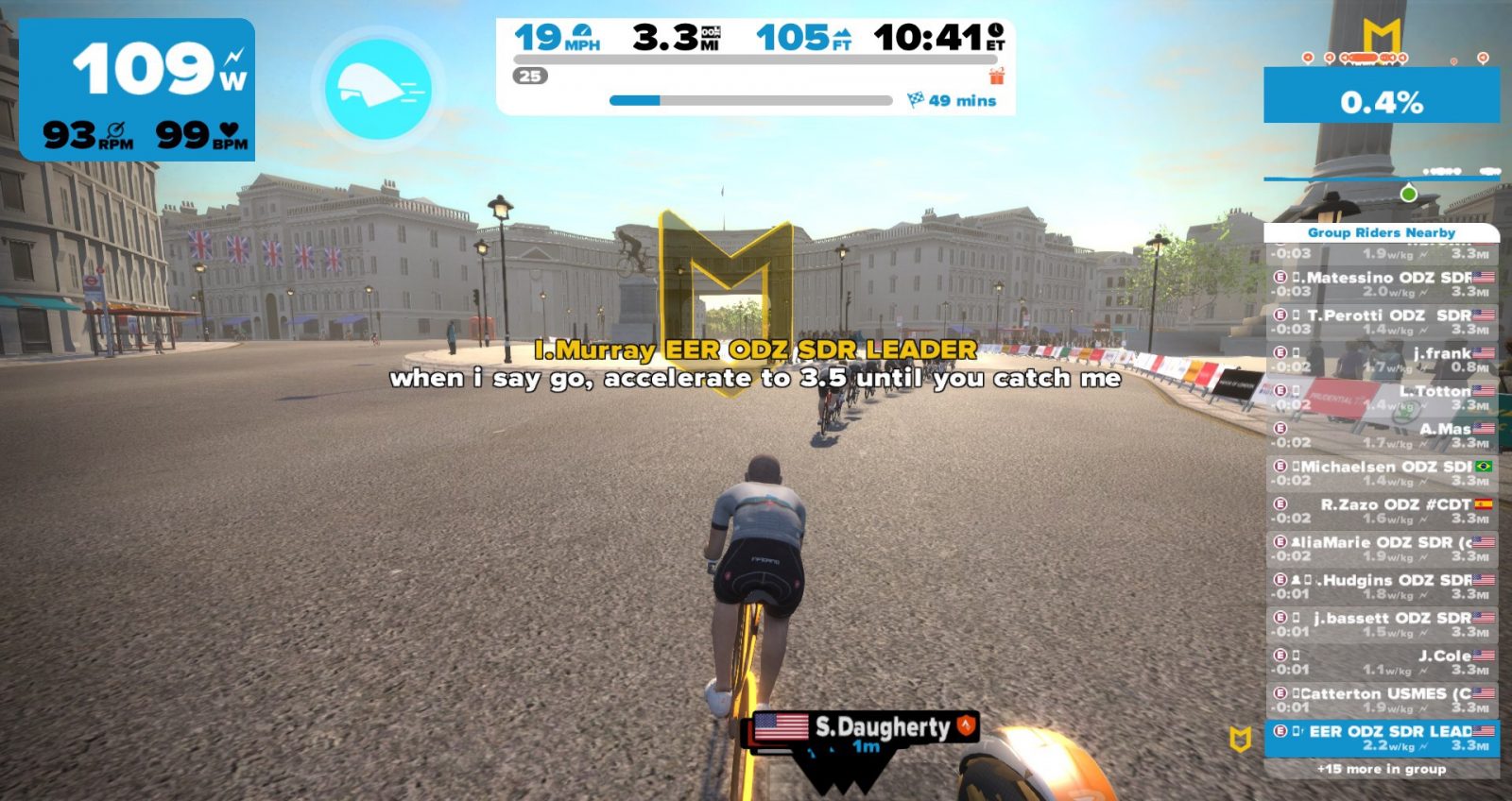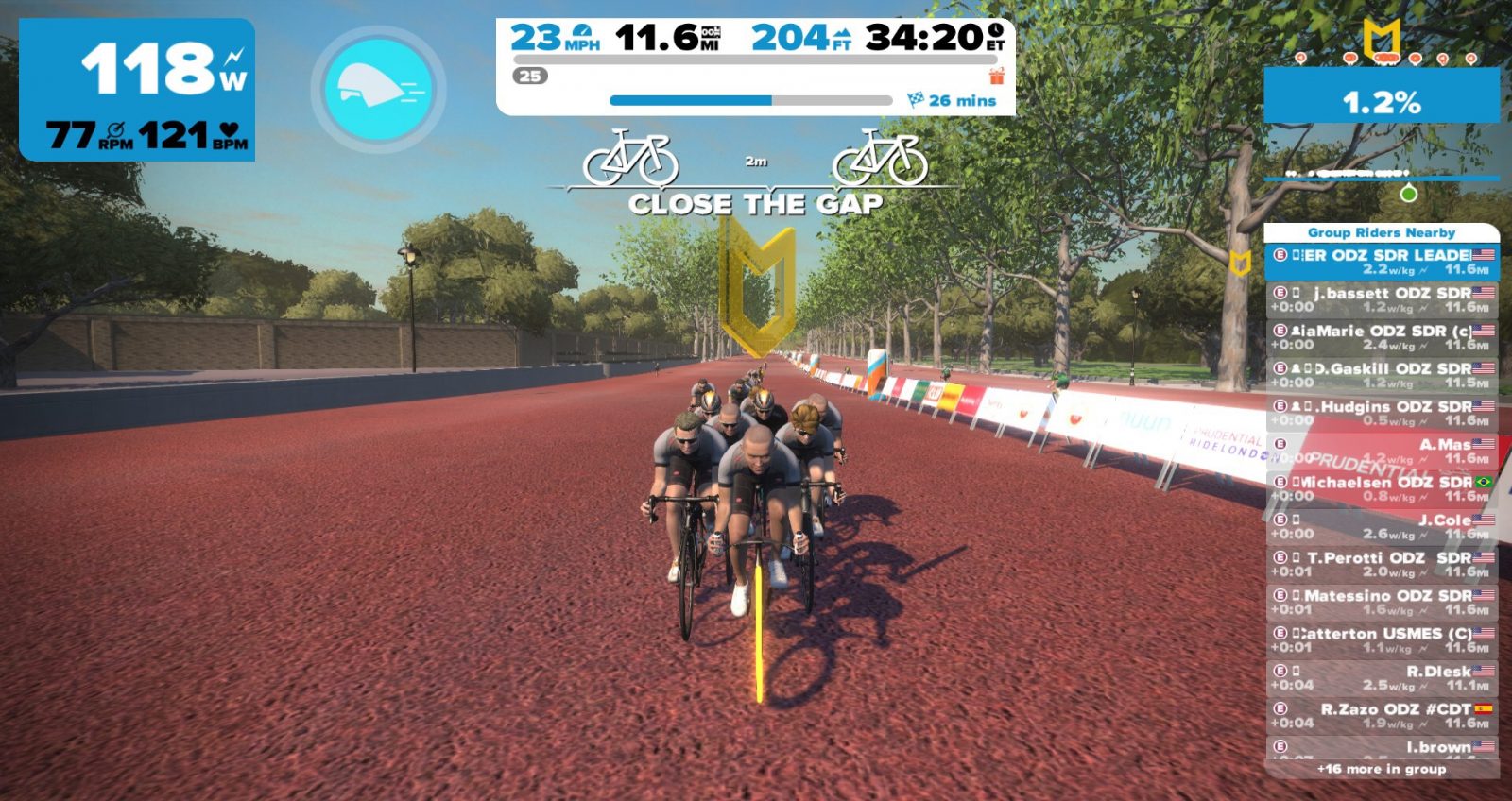ODZ SkillZ and DrillZ Ride, 21 June – Having run the Keys 100 from Key Largo to Key West, FL, two times, I am acutely aware of the difference between running on the protected land vs being on the unprotected bridge all by lonesome. Crossing the gap from one group on the road to another is pretty much the same thing. Today, we focused on crossing smaller time gaps. To see the complete video, check out Zwift Live by ODZ on Facebook or watch it below:
Why is it called bridging?
Well, the easiest way to explain the concept is to look at my earlier metaphor. Groups of riders offer safety and protection, allowing you to draft and get some respite. When you attempt to cross the gap, that move is usually done solo or with one or two other riders. During that crossing, you are left completely exposed to the elements, really the wind, and there is no assistance. Think of the groups of riders like islands in the vast sea of suffering we call a bike race. Between those islands, you have to cross that sea of suffering, fighting the currents alone and unafraid. The action of the crossing is like a bridge. Thus, we call it bridging.
All bridges are not created equal
In previous classes, we covered how to bridge a large gap of a minute or more. Today we discussed the shorter gaps. That does not mean that it is any easier. In fact, a ten-second gap could take just as long and be just as hard as a one-minute gap, depending on the effort being put in by those up the road.
Just think about it for a second: if the group up the road has a ten-second advantage and is riding at 20 MPH, and you close the gap at 21 MPH, it will take you nearly 3.5 minutes of solo riding to cross that gap. Depending on the effort required to go that 1 MPH faster, you could end up imploding before the catch. Going 22 MPH, though, cuts that time down by almost 2 minutes.
How hard of an effort can you hold for 90 seconds vs 3 minutes and 30 seconds? What about 60 seconds? Maybe it makes sense to go harder to cross faster, or maybe it doesn’t. It will all depend on what you can hold and for how long.

The burst bridge
Sometimes during a race, you daydream. It happens.
The pace settles, and you get into a rhythm. You drift back a little in the bunch and get comfortable in the draft.
Then, the bad things start to happen. It could be a crash somewhere in front of you. It could be a turn or a weather shift that changes the wind direction. Or, it could simply be an attack from the front of the bunch. Whatever the reason, all of a sudden there is a group five seconds up the road.
What to do? If it is big enough or has enough strong riders to hold off the pack, then you need to get to that group. The bad news is that you will have to throw in a monster effort. The good news is that it will be a short effort as long as the front group doesn’t drill the pace.
To bridge the gap, you need to get up to the higher end of your power abilities as quickly as possible. First, that will help you get away from your current group, potentially reducing the likelihood that the front group will hit the gas in an effort to keep the group from coming back together. Second, the quick burst will probably get you across the gap before the front group notices you coming, again limiting the group’s ability to accelerate to keep away.
Once you make the move and close the gap, you need to pay very close attention to your closing speed. One of the worst mistakes you can make is to put yourself on the front immediately upon arriving. All you are doing is setting yourself up to get attacked and spit out the back. Complete the bridge and ease into the back of the group. As you approach, let off the pedals a little bit. During IRL events, you can bleed off speed by sitting up a little higher or putting your nose in the wind for a second. DO NOT HIT YOUR BRAKES! If you hit your brakes, you will create a yo-yo effect. Just ease off as you approach.

The sparkler bridge
What happens if the attack you missed gets further up the road and doesn’t ease off the gas? Ooh, more bad news for you. You are just going to have to dig deep and hammer away. But be careful! This is not the time to throw down your sprint power in an attempt to set a new five-second record. No, you need to do some quick battlefield calculus to assess the damage you can sustain.
Yes, I said that you need to assess the damage you can sustain. The bigger the time gap and the harder the front group is riding, the more matches you will burn to bridge up to them if you can even do it. Remember, at 20 MPH, a 10 second gap is almost 100 meters. A 30-second gap is almost 3 football fields in length. Go to your local soccer park, and see how big of a gap that is. How long would it take you to cross that distance if your target was stationary? If your target is moving just slightly slower than you, it can feel like it takes forever to close the gap.
The reason I call this the sparkler bridge is that a sparkler is not particularly bright, nor is it loud. However, it’s still pretty darn hot. Try to touch a lit sparkler, you’ll see. [DO NOT TOUCH THE LIT SPARKLER! That would be just plain stupid.]
To make this bridge, you have to accelerate quickly and settle into a pace that you can hold for a good three to five minutes with the possibility of having to hold it for up to ten minutes. Think of this as ten-minute power. It will be hard. It will hurt. But, you need to ride as hard as you can sustain without going so deep that you are vulnerable once you reach the intended group.

The bridge to Attackland
Why keep something in reserve if you get to rest once you get to the back of the bunch? Well, the front group may not want additional company. Worse, if you overshoot, putting yourself on the front, and show fatigue (aka blood) to the group, they may attack you just on general principle. Why keep a rider around who has already shown the strength to make the bridge? If that rider recovers, he/she could be very dangerous later in the race. It’s better to attack the rider and get rid of the threat before it becomes one.
If you are not careful with your bridge, you could accidentally trigger a slew of attacks that end your bid for glory very early in the day. Think of it like clapping your hands in an avalanche-prone area. One small, inconsequential action could lead to personal devastation and destruction.

Wrapping it up
Bridging is tough row to hoe. During IRL events, you have no idea of the effort level being put out by the front group. If you are fortunate enough to have time splits, that’s what you have. On Zwift, you have the luxury of seeing what power everyone is putting out. It’s just up to you to match it and go harder. Like we discussed earlier, you have to keep something in reserve, and you have to protect yourself once you get in the next group up the road. Ease into the back of that group and try to recover without showing too much weakness.
Of course, the best way to avoid having to bridge is to maintain a good position in the bunch and being very attentive at all times. Once the race is on, there is no break. There is no down time, and no quarter is given. That’s it for now. Until next time, Ride On!



